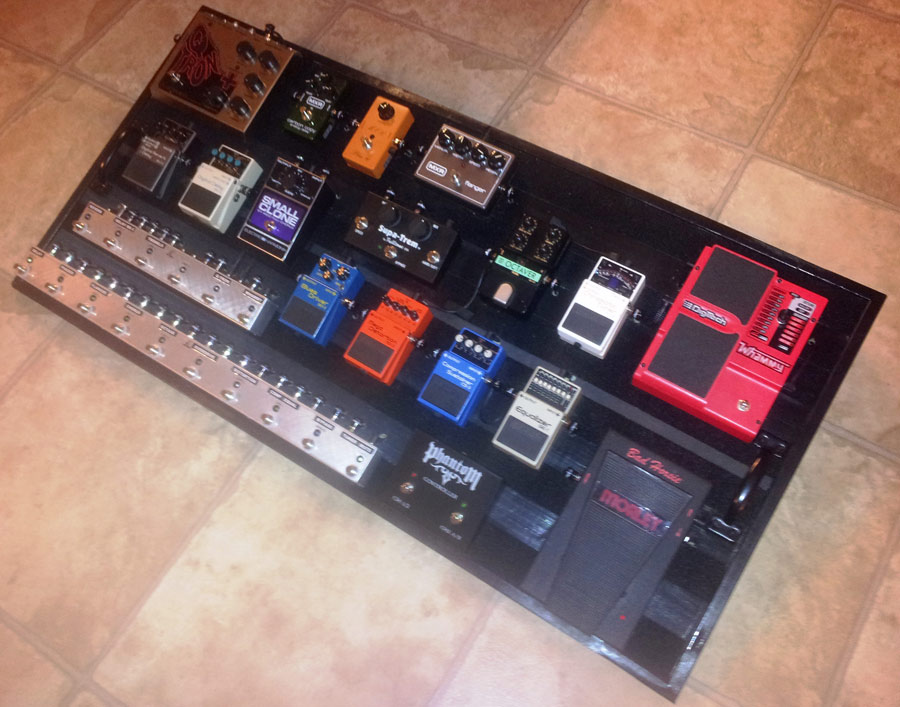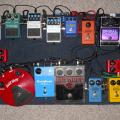Today’s pedal line is from Ryan Harris. If you have a pedal line (doesn’t have to be in a board) for your rig, please email me a photo, bio, description of pedals and routing to pedalline@nulleffectsbay.com. Every Friday I’ll showcase a pedal line submission. Make sure you include any links to your band or music page.
 I’m Ryan Harris from Olathe, KS. I’m an avid reader of effectsbay.com and want to thank you for providing this wonderful forum for all of us to nerd out over gear. I don’t have a band or music to promote, I’m merely a hobbyist who has played guitar for 18 years, and takes tone seriously. My goal is to have a versatile setup with many sonic options in order to play the wide breadth of music that I enjoy.
I’m Ryan Harris from Olathe, KS. I’m an avid reader of effectsbay.com and want to thank you for providing this wonderful forum for all of us to nerd out over gear. I don’t have a band or music to promote, I’m merely a hobbyist who has played guitar for 18 years, and takes tone seriously. My goal is to have a versatile setup with many sonic options in order to play the wide breadth of music that I enjoy.
Guitars and Amps:
My main guitar is a Paul Reed Smith Custom 24, with most of my auxiliary guitars being functional tributes to the guitarists who have influenced my playing: a John Mayer Signature Fender Stratocaster, a PRS Tim Mahoney SE (311) and a first run Fender Jagstang (Kurt Cobain).
My main amp is a Diamond Phantom which is a boutique style, 3-channel, high-gain tube amp, similar to a Mesa Boogie Triple Rectifier. It’s outfitted with 4 EL-34 Winged-C Power Tubes, and I dropped a high end 12AT7 pre-amp tube into Channel 1 to make shimmering clean tone. Diamond Amplification is a great company, always willing to talk shop, and address any questions or concerns.
Pedalboard:
The board itself is homemade creation measuring 44″ x 22″, made from 3/8″ MDF and reinforced and accented with various hardwoods. It was all sprayed glossy black and the top was covered with 2″ strips of industrial strength Velcro. It also has a 4.5″ rise. It has 3 handles and even though it’s as heavy as some amps, it’s sturdy and 100% mobile.
Power Supplies and Cables:
As much as I’m going for tone and versatility with my pedals, aesthetics and organization of my board were also paramount. Accordingly, I mounted two Voodoo Lab Pedal Power 2‘s on the bottom of my board, then drilled through to feed each pedal power. That way, the entire board instantly comes to life just by plugging in two power cables. The pedals are all wired and custom cut with George L .155 cable and nickel jacks. Most of the wiring is routed underneath the board as well, to show minimum cables to the eye.
Loop-Master:
My board is controlled by two Loop-Master switchers which afford me the luxury of having each pedal always on, within a foot-switch controlled independent loop making them all “true bypass.” The effect only enters the loop when its turned on by the foot-switch which allows the guitar’s signal to go straight through to the amp without deterioration. Moreover, I can bypass a switcher and “stage” an effects combination on one unit, while playing another effects combination on the other. Finally, they allow me to cut down on “tap-dancing” but still have my pedals nearby (as opposed to in a rack) to make ongoing knob tweaks.
I added some simple black labels indicating which pedal goes to which loop for convenience. The quality of the Loop-Masters are amazing, but it took me 17 weeks to receive my last order, which borders on absurd for any company.
Pedals: (In order of appearance in the signal path)
Phantom Controller:Â The foot-switch for my amp as mentioned above.
Boss TU-2 Tuner: Simple, reliable, had it forever, no reason to change brands. It’s routed into the Tuner input of Loop-Master 1, which also serves as my rig’s kill switch.
Morley Bad Horsie Wah: This is simple praise, but I love that the user does not have to depress the pedal and click it “on”. You press it down and it engages automatically. I wish more companies designed wah’s that work this way. I love the sweep range and responsiveness as well. I’ve owned various Dunlop’s and even had a 1973 King Vox Wah, but this one continues to maintain its presence on the board.
Boss GE-7 Equalizer:Â It’s great for a lead boost or subtle tweaks to my frequency depending on the guitar used.
Boss CS-3 Compression / Sustainer: This is an older model from 1987 and offers incredibly smooth sustain for solos, or adjustable snappy attack and punch when needed.
Boss MD-2 Mega Distortion: Try as I might, I can’t get rid of this pedal. It’s versatility, fuzzy sound, and rich low end have fought off an old Russian-made Big Muff, a ZVex Fuzz Factory, and every other Boss distortion pedal to earn this spot on my board.
Boss Blues Driver BD-2 Overdrive (with Robert Keeley mod): The pedal as a stand-alone was a bit weak, but the gain modification brings it to life. You can get a lot of great tones out of this pedal.
Pearl OC-7 Octaver: People are sometimes surprised to learn that Pearl (known for its drums), dabbled with guitar pedals in the 1980’s. This pedal beat out the 1985 Boss OC-2 Octave pedal that I had on my board for a decade because of how smooth it is and how accurately it adds an octave to each of the notes being played. It’s especially awesome for distorted single note riffs.
Electro-Harmonix Small Clone Chorus: I grew up listening to a lot of Nirvana so in my mind, a chorus should sound deep and watery. I would never say this is the best chorus pedal in the world, it’s just a personal preference.
MXR M-117R Flanger: This sounds great clean or pushing through hi-gain signal swirls. I’d love the Hartman or the A/DA instead, but this one provides the most bang for ones buck as I don’t use a Flanger enough to justify spending $250.
MXR Phase 90 (Script Logo) Phaser: This is the warmest, richest (non-vintage) phaser on the market. I love that a pedal with one knob can enhance one’s sound so much.
MXR Carbon Copy Analog Delay: I picked up this pedal mostly because of the high praise I kept seeing on Effects Bay–Â all of the positive comments people said were true.
Digitech Whammy: Obviously, this gets engaged to do the Muse / Rage high octave stuff that it’s primarily known for, but the pleasant surprise was the versatility of its other effects, particularly the deep and shallow “de-tune” functions that sound almost like a rotosphere. I end up using the de-tune effect to add dimension to single note riffs more than anything else.
Electro-Harmonix Q-Tron+ Envelope Filter: This is my favorite pedal on the board. Obviously the MU-Tron III is the holy grail, but the warm vowel sounds of this coupled with its responsiveness to my playing style just makes it a pleasure to use and keeps me loyal to the brand.
Fulltone Supa-Trem Tremelo: This pedal is a blast to tinker with. The basic function of tremolo is volume modulation, but this pedal expands those possibilities in many creative ways.
Boss DD-3 Digital Delay: I love the Strymon Timeline and the T-Rex Reptile more, but this pedal is compact, a workhorse, and has never let me down. It’s simple, precise, and the warmest (digital) delay I’ve ever experienced.
Boss RV-3 Reverb/Delay: This bad-boy has been discontinued by Boss, but it has 11 modes of reverb and delay making it great for sonic experimentation. It does the simple reverb thing like the RV-5, or wacky harmonizing spaced out type effects.
Thank you for taking the time to read about my setup. I’d love to hear feedback or answer questions. Cheers and thanks again for maintaining this site.
-
8 years ago
Nice board.
Reply
Guess you already knew, but you can daisy chain the PP2s so that you only need one power cable for the entire rig.




